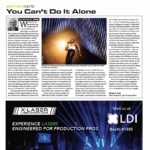“Attention all lighting manufacturers: Concerning the continuous rise in color temperatures in your discharge lights. Some of us LD’s still like the color red.”
This was a recent post on social media. The time has come to call out the system, the trend, the fact that almost everyone is sacrificing the LD’s right for a full color palette for more lumen output, higher CRI in LEDs and a native color temperature of 7,000° Kelvin in discharge fixtures.
Crickets
I test a lot of different new fixtures. Here’s an example of a conversation between myself and a lighting manufacturer that I had last month. I called them because I thought perhaps I was in the wrong mode or had an incorrect fixture library to test the fixture.
Me: “I like your fixture, but I’m having issues with the nonexistent color red.”
Manufacturer: Yes, we are aware. You need to roll the CTO channel to full, it helps.”
Me: “Tried that. Indeed it darkens the hue a little, and now I’ve lost about 1/3 of the lumens.”
Manufacturer: “Did you see how white the beam is?”
Me: “Sure did. So you’re basically admitting that you have made an LED fixture with 4-in-1 LED cells that is missing a primary color?”
Manufacturer: (After about 20 seconds of crickets) …“Seems that way.”
Three Out of Four
I spoke with LD Alex Reardon, the originator of the Facebook post, about this lack of saturated colors that seems to be prevalent in today’s market, and the fact that few companies are bothering to address the problem. Here’s his take. “We lighting designers work using color, not just brightness. So it would be rather wonderful if we could have access to the entire spectrum. Manufacturers have done marvelous, quite stunning work on brightness, functionality, and reliability since the dawn of the moving light, but now is a perfect time to expand on those three to include color.”
You know what bugs me more than this fact that LED fixture manufacturers have decided that R19 (fire) is a suitable replacement for R27 (blood red)? The fact that they think medium blue is acceptable as the most saturated blue we can use. Seriously, the largest selling, most popular LED fixtures found all over the world cannot give me a navy blue, let alone my beloved L119.
Without saturated reds, greens and blues, we cannot mix other colors correctly. Therefore most LED 4-in-1 cells cannot mix the primary color of magenta. I may get a Broadway Follies saturated pink, but the only way I can get magenta is if I lose most of the output of the fixture. I would love to use lavender and the color Congo blue again before I die.
This month, I lit a show on a campus where I had to use battery pack LED fixtures to uplight some columns in a deep magenta color. I put them in full white with all four channels at full. Then I taped some Lee 126 gel to the face of them. Sad.
I walked the floor at InfoComm last month looking at hundreds of RGB LED video walls. How come I can see beautiful saturated colors (including brown) on these walls, but the LEDs in my lights can’t do that? Isn’t an RGB LED an LED?
Earlier, at PL+S in Frankfurt, I spoke with Simon Canins, R&D director at Astera, about this. He points out that there are certain manufacturers who advertise a “blue” model of their fixture line that does utilize deep blue LEDs and, yes, he could use them in his lights, too, but that customers might not be happy. “We thought long and hard about the decision of which LED to use in our products., he says. “The bottom line was that the blue LEDs are more expensive and would add too much cost, thus the buyers would purchase a competitor’s product.”
But I see many companies all using the same LEDs from Osram. Does Osram offer an 8-in-1 LED that has a UV LED, a dark blue LED and a cyan LED? Perhaps. Or perhaps they should.
I come across the Mega-Lite booth at InfoComm and they have this new pancake light from PR Lighting on display. It’s a prototype version not released. I have their tech run it through the colors. I have an OMG moment as this light mixes a deep blue color with only RGBW parameters. The edges of the light beam are indigo. I ask the guys what LED source is in there. They shrug and say, “Something Osram.” Somehow this color blue is great in this fixture. But of course, there is no good red.
I bet if someone can offer an LED pancake light with all ROYGBIV saturated colors, there would be a line around the block of LDs spec’ing them. Regardless of the cost.
For Nook Schoenfeld’s introduction to the July 2017 issue of PLSN, go to www.plsn.me/201707ednote


